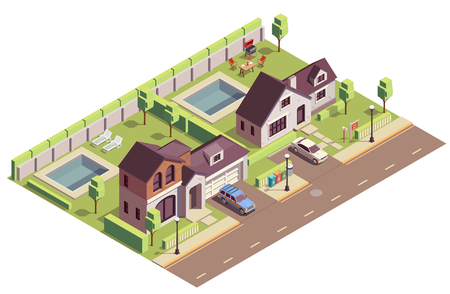1. Understanding 15-Year and 30-Year Mortgages
If you’re considering buying a home in the U.S., one of the biggest decisions you’ll face is choosing between a 15-year and a 30-year fixed-rate mortgage. Both options are popular with American homebuyers, but they work differently and can impact your financial future in unique ways. Let’s explore what sets them apart and how each loan term fits into the real estate market.
What Is a Fixed-Rate Mortgage?
A fixed-rate mortgage means your interest rate stays the same for the life of your loan. This gives you predictable monthly payments, which makes budgeting easier—something many Americans value when planning their finances.
Key Differences Between 15-Year and 30-Year Mortgages
| Feature | 15-Year Mortgage | 30-Year Mortgage |
|---|---|---|
| Loan Term Length | 15 years | 30 years |
| Monthly Payment Amount | Higher | Lower |
| Total Interest Paid Over Life of Loan | Less | More |
| Interest Rate (Typically) | Lower | Slightly Higher |
| Builds Home Equity Faster? | Yes | No, Slower |
| Flexibility for Other Expenses? | Less Flexible (due to higher payments) | More Flexible (lower monthly payment leaves room for other needs) |
How Each Option Works in the U.S. Market
The 30-year fixed-rate mortgage is the most common choice among American homebuyers because it offers lower monthly payments. This makes it easier for first-time buyers or those with tighter budgets to afford a home. However, you end up paying more in interest over time.
The 15-year mortgage is popular among buyers who want to pay off their homes faster and save on interest costs. While monthly payments are higher, you build equity much quicker, which can be appealing if you have a stable income and want to own your home outright sooner.
Your choice will depend on your financial goals, budget, and how long you plan to stay in your home. By understanding these key differences, you’ll be better prepared to choose the option that fits your long-term plans.
Monthly Payments and Affordability
When deciding between a 15-year and a 30-year mortgage, one of the biggest differences youll notice right away is the monthly payment. This difference can have a major impact on your household budget and how comfortable you feel with your finances.
Comparing Monthly Payments
A 15-year mortgage comes with higher monthly payments because youre paying off your home in half the time compared to a 30-year loan. On the other hand, a 30-year mortgage spreads your payments over a longer period, making each monthly payment lower and often easier to fit into your budget. Heres a simple comparison for a $300,000 loan at typical interest rates:
| Loan Term | Interest Rate (Example) | Estimated Monthly Payment |
|---|---|---|
| 15-Year Fixed | 5.0% | $2,372 |
| 30-Year Fixed | 5.5% | $1,703 |
*Estimates do not include property taxes or homeowners insurance, which may add to your total payment.
Budget Impact for American Households
The lower monthly payment of a 30-year mortgage can free up cash for other needs—like saving for college, retirement, or handling unexpected expenses. This is especially important for families juggling multiple financial goals or those who might be buying their first home.
A 15-year mortgage requires more discipline and room in your monthly budget. While it means you’ll pay off your house faster and save money on interest in the long run, it can also put more strain on your finances every month. For some households, this higher payment could limit flexibility when it comes to emergencies or lifestyle choices.
Which Loan Term Fits Your Finances?
If you’re looking to minimize your monthly expenses and want extra breathing room in your budget, the 30-year mortgage is usually more manageable. However, if you have stable income and want to build equity quickly while saving on interest, the 15-year option might be worth considering—even though it’s a bigger monthly commitment.
Key Takeaway: Consider Your Comfort Zone
Choosing the right mortgage term isn’t just about what you qualify for—it’s about what fits your lifestyle, current budget, and long-term financial plans. Be realistic about what you can comfortably afford each month so that owning your home feels like a blessing, not a burden.

3. Interest Costs Over the Life of the Loan
When deciding between a 15-year and a 30-year mortgage, one of the biggest differences is how much interest you’ll pay over the life of the loan. The loan term plays a huge role in your total costs, and understanding this can help you make a smarter decision for your financial future.
How Does Loan Duration Affect Total Interest?
With a 15-year mortgage, you pay off your home twice as fast compared to a 30-year mortgage. Because you’re borrowing money for a shorter period, lenders usually offer lower interest rates on 15-year loans. Plus, since you’re making fewer payments overall, less interest accrues over time. On the other hand, a 30-year mortgage means more monthly payments and more time for interest to add up—even if your individual payments are smaller.
Comparing Interest Paid: Example Scenario
Let’s break it down with an example. Imagine you’re buying a $300,000 home and putting down 20%, so you borrow $240,000. Here’s how much interest you’d pay with typical rates (for illustration):
| Loan Term | Interest Rate (Example) | Total Interest Paid | Total Payments (Principal + Interest) |
|---|---|---|---|
| 15-Year Fixed | 5% | $101,543 | $341,543 |
| 30-Year Fixed | 5.5% | $247,220 | $487,220 |
What Do These Numbers Mean?
If you choose a 15-year loan, you’ll save almost $150,000 in interest compared to the 30-year option (using these sample rates). The higher monthly payment may feel like a stretch at first, but you keep much more of your money in the long run. With a 30-year mortgage, while payments are lower each month, the longer timeline means significantly more goes to interest.
4. Building Equity and Financial Flexibility
One of the most important differences between a 15-year and a 30-year mortgage is how fast you build equity in your home. Home equity is the portion of your property that you truly own, which grows as you pay down your principal. The faster you build equity, the more financial freedom you may have for future needs or goals.
How Quickly Do You Build Equity?
With a 15-year mortgage, you pay off your loan much faster because each monthly payment covers more of the principal balance. This means you gain equity at a much quicker pace compared to a 30-year mortgage, where payments are stretched out over a longer period and early payments go mostly toward interest.
| Mortgage Term | Equity Built After 5 Years | Total Interest Paid (Est.) |
|---|---|---|
| 15-Year | Significantly Higher | Much Less |
| 30-Year | Lower | Much More |
Pros and Cons for Financial Goals
15-Year Mortgage Advantages:
- Faster Equity Growth: Great if youre planning to sell, refinance, or tap into your homes value soon.
- Saves on Interest: You’ll typically pay much less interest over the life of the loan.
- Simpler Path to Full Ownership: You own your home outright sooner, giving peace of mind and flexibility.
Potential Drawbacks:
- Higher Monthly Payments: May strain your monthly budget and leave less room for other investments or unexpected expenses.
- Less Cash Flow Flexibility: Committing to higher payments could limit savings for retirement, travel, or emergencies.
30-Year Mortgage Advantages:
- Lower Monthly Payments: More manageable for many families, freeing up money for other financial priorities.
- Cushion for Other Goals: Easier to balance homeownership with retirement savings, college funds, or building an emergency fund.
Potential Drawbacks:
- Slower Equity Build-Up: It takes longer before you own a significant share of your home.
- Pays More Interest Overall: You’ll end up paying much more in interest over time.
Which Option Offers Better Flexibility?
If building equity quickly is important to you—perhaps to borrow against your home later or just to have more financial security—a 15-year mortgage could be the better fit. If having lower payments fits better with your lifestyle and long-term financial plans, a 30-year mortgage may provide more day-to-day flexibility. Consider how each choice aligns with your personal goals and comfort level when making this decision.
5. Which Mortgage Is Right for You?
Choosing between a 15-year and a 30-year mortgage depends on your current life stage, financial priorities, and future plans. Let’s break down how you can decide which option fits your situation best.
Consider Your Life Stage
Young Professionals: If youre early in your career, you might prefer the flexibility of a 30-year mortgage. It comes with lower monthly payments, which can free up cash for other goals like building an emergency fund, paying off student loans, or saving for travel.
Growing Families: If you’re planning for kids or already have a family, a 30-year mortgage may offer more breathing room in your budget. This extra cash can help cover childcare, education, or unexpected expenses.
Nearing Retirement: If you’re closer to retirement age and want to be mortgage-free sooner, a 15-year loan could make sense. While the monthly payments are higher, youll pay off your home quicker and save significantly on interest.
Match Your Financial Priorities
| Priority | Better Fit | Why? |
|---|---|---|
| Lower Monthly Payments | 30-Year Mortgage | Spreads payments over a longer period, reducing monthly costs |
| Savings on Interest | 15-Year Mortgage | Pays off faster so you pay much less interest overall |
| Building Home Equity Fast | 15-Year Mortgage | Larger chunk of each payment goes toward principal early on |
| Flexibility & Cash Flow | 30-Year Mortgage | Keeps more money in your pocket each month for other needs or investments |
Think About Your Future Plans
- If you plan to move in a few years: A 30-year mortgage keeps payments low if you won’t stay in the house long-term.
- If you expect income to rise: Starting with a 30-year loan but making extra payments when possible can offer flexibility now and savings later.
- If stability is key: A 15-year mortgage offers peace of mind by eliminating debt faster—great if you want to enter retirement without a mortgage.
Common Scenarios Americans Face
- A first-time homebuyer with limited savings: Often chooses a 30-year loan for affordable payments.
- A dual-income household aiming for early retirement: Might opt for a 15-year loan to own their home outright before leaving the workforce.
- A family juggling college tuition and other debts: Likely benefits from the lower monthly commitment of a 30-year mortgage.
- An investor or frequent mover: May prefer the flexibility of lower payments and invest savings elsewhere with a 30-year loan.
Your Choice Is Personal—and Can Evolve Over Time
The right mortgage isn’t just about numbers—it’s about what works best for where you are in life. Take time to think about your current needs and long-term dreams. It’s also common for people to refinance or adjust their strategy as their circumstances change. Whatever you choose, make sure it supports your financial well-being and future goals.


